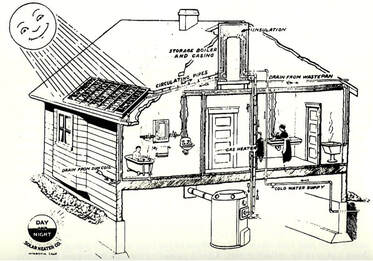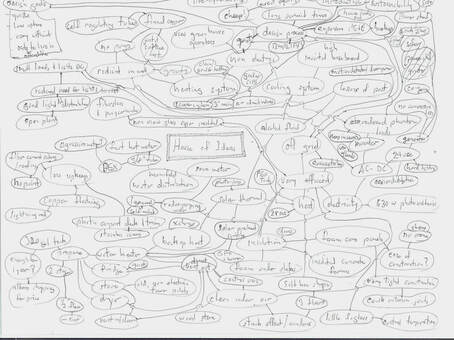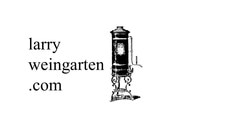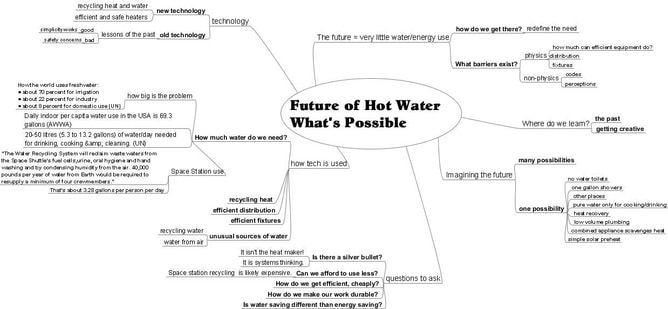 Although I don’t go as far back with solar water heating as Day and Night Solar, I am one of the old guys in the field having built my first system in 1978. I installed new solar right up to the end of tax credits in 1986. Then 90% of the solar companies in my area vanished and I took on keeping all those local orphan systems running. What I saw taught me a lot about how not to do solar. People had installed copper coils in galvanized tanks. This caused the tanks to leak within a year or two. Some installed the solar tank downstream of the electric “backup” tank, so electric was heating the solar tanks. Just imagine that meter spinning! Drainback systems were put in so they couldn’t really drain back, and pipes froze. The wrong insulation was used and would melt off the pipes, or no insulation was used at all, or was sloppily installed, so it didn’t really work. Pumps would come on during freezing weather, so pipes that would have been fine, burst because of controls poorly set up……… I saw systems so complex that it took a longish time to figure out what the installer might have had in mind. Systems like these reminded me of being inside of an older style diesel submarine with pipes running everywhere. Perhaps the installers were proud of these systems because it was common that they had no insulation… probably to show off all the shiny copper piping! If you’re going to have a system like that, you need to build a separate bedroom for the installer as he or she will be spending a LOT of time at your place. At least put a cot in the mechanical room! So, I got to learn a few things. First is Elegant Simplicity. This matters because the more complex something is, the more ways it has to misbehave. Just think of the interactions between parts. If there were only two parts, that’s two interaction. Three parts means six interactions. Four parts means twelve interactions, and so on. Keeping things simple, by actually putting the properties of the materials to use, is a great way to build a durable system. The only problem is that it requires thoughtful design. I had the pleasure of working with Steve Baer, of Zomeworks in New Mexico. He was a champion for the practical application of elegant simplicity, and he wrote a lot of good things too. The book: “Sunspots” is likely his best-known work. If you want durable and efficient systems, elegant simplicity is THE way to go. It’s also useful to study the history of solar, so that you understand the ideas that have come before. See if you can find a copy of “A Golden Thread: 2500 Years of Solar Architecture and Technology”. It’s a fun and useful read! It also makes sense to design systems that are a good match for the people living there. A very complex system might be fine for the plumber or engineer who likes to tinker, but not so good for the busy professional who works primarily with their mind, rather than their hands. I learned that most people ignore maintenance, so it becomes important to design systems that may only need to be seriously looked at about every five years. That’s hard to do. Also, they need to be designed to fail in a safe way, rather than failing so water leaks out or steam from stagnant collectors fills the garage! One of the most common systems around the world is the thermosyphon type. It places the storage tank above the collectors so warmed water flows by convection from the collectors up into the tank. Having no controls or pump to fail is simpler! Even so, that type of system doesn’t do well in cold climates, but there is no need to have only one system type to cover all areas. There might be places where photovoltaics should power a heat pump, just because any outdoor plumbing is risky. Leaving the past for a bit, I’ve more recently built systems that come pretty close to being simple and perform far better than conventional solar, along with costing about half as much. The key to doing this is to not look for the most efficient collector, but rather, an inefficient collector! By having more square feet of inefficient collector area, you get more BTUs and eliminate the risks and design challenges of overheating. By using the right type of plastic collector, you nearly eliminate the risk of freeze damage. Also, the collectors cost less and are even something that a handy person could make themselves. Add to this, using a well-insulated plastic storage tank and “too much” insulation on the lines allows this system to take care of 90% of the user’s hot water needs! Also, there is very little to maintain. Not bad! A normal “good” system can do 70 or 75% and many do far less. Throw in a little efficiency in the plumbing distribution and fixtures and you will be able to take long, luxurious showers and still be efficient! I’ve only skimmed over the topics of history, design, and efficiency. Still, I hope you understand now that solar thermal can be done well and cost effectively. It does not need to be relegated to the dust bin of history. But, it must be done thoughtfully to work well, long term. Yours, Larry
0 Comments
Sometimes the best way to show ideas is with a picture. Below is what’s called a mind map. It’s a form of outline that’s not linear, so it allows for more spontaneity and brainstorming. These are useful things when we feel a need to get out our crystal balls and peer into the future, or make plans for how we want our future to be. If you look closely at the map above, you’ll see or be led to questions about what can be. That’s fine, as asking good questions is a great start to understanding. So, just have a look and think about the choices we have and actions we can take to have durable, plentiful, and very efficient hot water.
Yours, Larry  I’ve been asking myself that question for a long time. For me, it’s been a good question to ask. As a young person, I had a lot of “No, you can’t do that!” and “That’s not how to do it!” told to me, but I have a stubborn streak. Grownups are supposed to know better, so I listened, but as I got more experience in the world, I questioned the old beliefs, rules and dogmas. The title question helped a lot in sorting out what rules made sense and which ones really didn’t apply. One of the ones that didn’t pass the test was “statement made to me”, followed by “Because I say so!” In my mind that translated into “I don’t really know why I’m telling you to do this and I’m not going to put effort into figuring it out and explaining it to you. Just do it, because.” One lesson I learned came of this conversation I had with my father as a pre-teen… Dad asked me if I would “like to” wash the car. I answered his question honestly, no. He blew up and went on a tirade about how he paid all the bills, and I should be grateful… and so on. If he had simply told me to wash the car, I would have done that with no problem. He tried a mind game on me, and it didn’t work. I was raised at a time when the father went out to earn money and the mom stayed home and tried to not be driven crazy by the kids. Dad clearly hadn’t learned the nuances of being around kids. My lesson from this was that parents don’t really have any training in parenting. They wing it! Grandparents are the ones who have been through it and can more reliably do a good job of parenting. This event helped lead me to questioning all the rules. Asking “what’s the worst that could happen” is an exercise in thinking something through and really attempting to understand it. It’s a fact-based way of looking at things. This question has allowed me to make progress when others would have had me give up. It’s also a way of looking at things as if they were new, with no assumptions or history cluttering up the decision-making process. It is not a get out of jail free card. If I felt like going down a dirt road fast on my bicycle, asking a good question isn’t going to keep me from sliding off the road at that sharp turn and getting all scraped and banged up! That’s called learning the hard way. Asking the question in the title lets you see what really could go badly and take precautions to prevent that from happening. It actually increases your chances of success. There is no magical thinking here, it’s just a tool for better understanding how things can go, so you can plan better and be more successful in getting the things done that you want to do. This was more philosophy than plumbing, but it’s a new year! Heck! Yours, Larry  I’m a contractor who grew up with an uncle who was an architect, and a brother who is architect. So, I’ve been exposed to what’s out there in the built world, both good and not so much, and I’ve gotten to peer into the thinking of what homes should be able to provide for their occupants. So much of how we build homes is tradition driven. Our predecessors developed ways of doing things when the building landscape was vastly different than it is now. Also, there is an ongoing crisis in housing in that it’s become unaffordable for many people. Sadly, there are architects out there who design for magazine covers. This means they are doing showy work, with the hope of gaining some celebrity status. All fine except it might mean they aren’t really working to do the best job for the clients and their needs. Then there are the contractors who compete to get the job through the usual bidding process. This forces them to leave little margin for error or when things change, so they work fast and cheap, cutting off any corner they can find. Don’t forget that building to code is a minimum standard. Bragging that you build to code is like saying proudly that you do D- work. Then there are the owners, who want a good job, but are really not educated in all the nuances of getting a building built and don’t even know what questions to ask. That can be where unhappy surprises come from. I haven’t mentioned the planning and building departments, where rules seem to be made at a whim, change often, are seldom explained well, and then they are not enforced evenly. Inspectors sometimes act like demigods and interpret the codes however they seem to feel like that moment. Throw all these competing and conflicting interests together and it’s no wonder why building is usually one of the most stressful and expensive experiences a homeowner ever goes through. With each category above, there are the good exceptions, where professionals actually act professionally and are helpful, but that is certainly and sadly, not the rule. There are ways around much of the mess described above. Two ways are to buy a really run-down house and do a major remodel, sometimes called a gut rehab to the house. I’ve heard of these where the owner had everything but the front door torn down, so the word “remodel” is sort of a joke. When building departments are really difficult to deal with, this approach may be easier than starting from scratch. Another approach is to use manufactured housing to build with. This puts the construction under federal guidelines and removes much of it from the jurisdiction of local authorities. If you go this way, it’s important to really do your shopping. Manufactured housing suffers from cost cutting, or “cheapifying” in a big way. You want something that will hold up and perform well for many decades if not hundreds of years, and that will take some exploration to discover. Thinking just of the cost of energy; why not build so your home will still be considered efficient fifty years from now? Where is the joy in building something that will be obsolete in five or ten years? Also, manufactured housing is looked down on by many in the trades because of that cheap reputation and usually lower resale value than standard stick-built housing. I once saw a video of what it would look like to build a car in the middle of a muddy field versus building it on a production line in a factory. That video drove home the point that houses would be far better off being built under controlled conditions, where templates and jigs were all set up for accomplishing precision work in a dry, flat and clean environment. It could be a smart way to get quality housing for a lot less money, time and frustration. I chose a middle ground in building my house. I used SIPS, which stands for structural insulated panel system. You give the manufacturer a plan and they cut panels for you to assemble. You pour your foundation and assemble the panels on site. It’s a far faster and more precise way to build, and you get a much more energy efficient shell for the house going this way. In my experience, although the materials cost a little more, they save in labor costs, so ultimately you get a better home for no more money. As I did much of the labor on my home myself, my costs were far below the going rate for new construction at the time… on the order of $100 per foot versus $250 per foot. Savings added up pretty fast! Also, I got to put in far more insulation than was thought to be sane at the time. It allowed me to put in a tiny power system and now nobody is telling me how silly my thick insulation is. There are other things to consider in building that often get overlooked, mostly because of tradition and habit. We commonly build homes with crawl spaces and attics. These are wonderful places for rodents, bugs, and energy loss in various ways. They are useless as living space, which is what people build homes. We build these spaces anyway so that there are places to put mechanical systems and plumbing, but with a little thought, we can do better! If we insulate under concrete slabs, that concrete becomes thermal mass for the house, keeping temperatures more even. Plumbing that must go under the concrete may be put in conduit, so it is protected from damp soil and is simpler to replace if needed. Electrical can be done the same way. If the shell of the house is well insulated and air-tight, the heating and cooling load will be far smaller and simpler to meet with much less equipment. I remember reading that a ½” water line can carry as many BTUs as an 8” air duct. It’s a lot easier to fit a small line into a building, and if the loads are kept down, you won’t even need much of that small line. So, making the building efficient both in terms of energy and space, contributes to needing a smaller and simpler heating system. The concept of “Passive House” takes this farther, suggesting that with a good enough shell, a heating system isn’t needed at all. Another way in which homes could be built to take care of their occupants needs better would be to design them with the natural surroundings taken into account. Where does the sun rise and set? What are the prevailing winds? When might cooling be needed? Understanding things like these allows the building to be more comfortable and energy efficient at the same time. The purpose of a home isn’t to ignore and disconnect us from the environment surrounding us. Done well, it should help us reconnect, but most modern homes are oriented to make it easier for the car to come and go, rather than for the people to easily relate to and benefit from their surroundings. My point with all this isn’t to go off on a rant but to suggest thinking a bit differently. This way, we can get greater benefit, and at lower cost, both financially and emotionally from our homes. Would you rather have an OK place to live, or a wonderful home to live in? It really is your choice! Yours, Larry  I’m a bit of a fanatic when it comes to tools. The right tools let me do things that most tradespeople shy away from. Part of my “luck” in knowing about the right tools is that I enjoy looking into the past. Our forefathers came up with some wonderful tools, but we seem now to have forgotten about them, or never learned. Interestingly, a similar thing applies when it comes to materials. We have so many materials to play with now that it’s fun to imagine what Leonardo DaVinci would come up with, if given the full range of things we have to build with. His helicopter might actually fly if built with the right lightweight modern materials, and with stronger motors! One goal is simply to understand the properties of all common materials. The other goal is to see how things can be used effectively for something other than their intended use. With these understandings, it becomes possible to use things “wrong” and get away with it! In building my house, I used coat-hooks instead of standard knobs on the cabinets. Why? To start, they are easy to use with only one finger. Over the years, I’ve seen how the finish around cabinet knobs has deteriorated from the oils on our hands. Using a coat-hook prevents touching the wood finish, so the cabinets will need to be refinished less often. Mine show no signs of damage after about fifteen years. Coat hooks cost less than knobs. And lastly, I can hang things on them! Understanding that you’re not (usually) breaking any laws by using things in a way they were not designed to be used, teamed up with an understanding of materials can really open up the choices you have for problem solving and designing things. I used roofing materials on the exterior walls of my house. There is no code saying you cannot use more durable materials than is normal. I understand why gold plumbing is rare, but in the right circumstances, roofing material can be less expensive, more durable and fire resistant than conventional siding. Done well, it’s also far less upkeep. One final example of using things wrong is that I was looking for a way of getting heat into my house, radiantly, through the walls. I thought about the finned copper tubes that you see in solar collectors. They collect heat from the sun and put it into the water. Why can’t this process be reversed? I use warm water flowing through the tubes to put heat into the copper fins and into the house. Just because it was designed to have heat flow one way, doesn’t mean it can’t flow backwards. Understanding material properties lets you re-envision how things can be used, successfully! A bit more about misusing tools… Those old tools our predecessors made are generally made of better steel than what you can buy now. That means you can work them harder. I’ve collected lots of old pipe wrenches and many were designed to encourage you to put a “cheater” on them. A cheater is usually just a length of pipe that fits over the handle of the wrench. If you do that with some modern tools, you’ll break the jaw at the head of the wrench. How do you think I know this 😉? Old tools can withstand much greater force without damage. Old tools came in a variety of patterns not seen today and this allowed you to easily get the tools into places a modern wrench wouldn’t fit. A good example would be tight quarters where the normal wide jaws of a modern wrench simply don’t fit, like in between screwed fittings. You get around this problem using a smaller old pipe wrench and a cheater. The higher quality steel in the old wrench lets it take the force needed and the cheater lets you exert the force without undue strain on your body. Knowing the properties of materials lets you do this successfully. I really enjoy ideas. Ideas can come from the past. They can come from different fields of experience; like how plumbing helps inform medicine and visa-versa. Ideas come from using different perspectives than is normal. An example of this is building your home for what energy will cost towards the end of the home’s life. Energy seldom gets cheaper, so what will it cost fifty or one hundred years from now when your home is in middle or old age? Thinking about these things will likely encourage you to install much more insulation than you would have done just to meet code. Insulation is cheap, yet people find excuses to use as little of it as they can get away with. This makes places more expensive to heat and less comfortable to live in. It also tips the scales towards needing to rehab the place sooner than later. Ideas are surprisingly easy to collect, sift through and put to use in ways that can make life nicer in all sorts of ways. Misusing tools and materials in creative and effective ways is just one way of putting some unusual ideas to work. It only requires understanding the material properties and getting into the habit of asking “What if …”. Yours, Larry  The title is sort of a trick question as the answer will be different for different people and their differing needs and skill sets. Looking up the definition of investment, the broadest one is “an act of devoting time, effort, or energy to a particular undertaking with the expectation of a worthwhile result.” There is an investment guru, Garrett Gunderson, who talks about finding your investor DNA. To me, this is about knowing your own strengths, and weaknesses. Knowing what makes you uncomfortable because it feels too risky, and what drives you. And, what do you want to accomplish in this life? Here’s a link to more detail on just what this is: https://5dayweekend.com/keep-more-money/investor-dna-worksheet/ I like it in part because it’s not the same old stuff we’ve been given all our lives… essentially scrimp and save, which people seldom do well. Clearly, financial literacy* and street smarts about investing are not taught in most schools. We as a nation, have a pretty dismal understanding of how money works. That may be why the top one percent of Americans have roughly the same net worth as the entire middle class. Here’s an article about it: https://www.bloomberg.com/news/articles/2019-11-09/one-percenters-close-to-surpassing-wealth-of-u-s-middle-class Mr. Gunderson is looking at things using a different perspective and I’m a fan of having multiple perspectives! I don’t know for sure that his methods work, but no doubt how well they work depends a lot on the student. Using his DNA worksheet, it becomes clear that real estate is a good fit for me because I’m comfortable with it. Also, being a contractor, I can fix it up, and give it value, both with my hands and what I know about building and efficiency. I can take something that was thought to be a tear down and make affordable housing from it, so there is a social goods piece as well. I get to help people. My father was a lawyer, but he did well with real estate because he was able to fix up legally distressed properties. So, what are you good at? What do you like doing? Can you bring those talents to an area that needs them and will reward you for using them? Back to the title, have you considered that investing in yourself is probably the finest investment you can make? That investment has the possibility of paying back for the rest of your life! I’ve had the same Skilsaw for over forty years. It probably cost $40 way back when. I’ve built homes with it, and a lot of other stuff. I’m pretty sure it was a good investment! Even more important is that I’ve been lucky with mentors. Good people have been willing to teach me some of what they know, and those lessons continue to pay me back for the time I spent learning. My mentors invested their time in me and I’m not about to let that time be wasted. So, what is a good investment for you? If you think about what matters to you, what you’re good at, what you want to learn, and what can help you reach financial independence, it should become pretty clear where your investment energy should be put. Yours, Larry *Financial literacy is a study unto itself and an interesting one. Here’s a quick definition: “Financial literacy is the ability to understand and effectively use various financial skills, including personal financial management, budgeting, and investing. The lack of these skills is called financial illiteracy.” If you do a search for “financial literacy training”, you’ll see some good info to, at a minimum, help you ask good financial questions.  I write this from the desk in my house. A few days ago, it wasn’t at all clear if this desk and the house it’s in would still be with us now. I took the photo you see here from the deck of my house in the evening. Smoke lit up by fire, and not far away at all! That night I was up every half hour to monitor the fire’s progress. This all happened during a heat wave as well. I couldn’t open windows at night to cool things off because of how thick the smoke was. Some nights, it got down to 88 degrees F inside. Heat, or smoke to breathe, your choice. I chose heat. The cats were non-plussed! I finished building this off-grid house fourteen years ago. Knowing it was out in the sticks, I did a lot to make it fire resistant. Much of the roof is cement tile, on top of rolled roofing. It has Hardi-Shake for siding. There are no vents for embers to get into and cause problems. Handrails around the house are made of steel. The house is sprinklered inside and has a fire hydrant and hose outside. When testing out a four-inch hose, I had to point it up. Pointing down would lift me off the ground! I even have decent clearance from vegetation around most of the house. I used a hot Mapp-gas torch to test materials. FYI, Mapp burns at 3,670 F in air! Even the Trex decking sample did not sustain flame very well at all, so that’s what I used. In those fourteen years, we’ve had a lot of experience with fires and have learned some things. I was just told yesterday that firefighters are bypassing homes with Trex decks because they are considered too difficult to protect. Ug! When I built the house, keeping vegetation from being right up against the house was thought to be good, now people are saying they want 100 feet of clearance. Big ug! I think I did a pretty good job of making the house fire resistant, but I’m not emotionally detached enough to be able to look forward to seeing how well it does in a real fire. I also didn’t factor in what mandatory evacuations would be like. Law enforcement and the firefighters just don’t want you around! Someone trying to protect their home is considered a liability, or someone that probably will need to be rescued. What’s the point of having a mini fire station if you can’t/shouldn’t stay to use it? And I hadn’t considered the pressure from family and friends to get out. Knowing what’s really the right thing to do, gets harder in a fire. Consider your escape route. If you stay behind to protect your home, but eventually find that the fire is winning, do you still have a clear way out? I have a long driveway through the brush and trees. I imagine it’s no fun staring down a life or death decision like that. Fortunately, the fire stayed away, and I can sit here with only a faint smoke odor and write. But now I have a new task, which is to figure out how to make this place even more resilient and able to defend itself from fire. I suppose I’ll be cutting some trees further back, whacking down some weeds, and figuring out how to “harden” my plastic water tanks so they are able to survive a fire. Perhaps there are shutters, like they used to use in California’s gold country, that can go over windows to secure those weak spots. Maybe exterior sprinklers? And??? Our climate is changing these days, and now in California, fire season is thought to be year-round. Fires have changed also. I’ve heard firemen describing them as hotter and faster. And it’s not just the wildland fires, but fire in towns with little vegetation, have jumped from house to house to house. Seemingly resistant houses, like those covered in stucco are no longer immune. With big or fast fires, the fire crews can do little but try to get people out safely. Maybe it’s time to consider underground houses again! Whatever, we need to understand the changing science around fire and buildings so we can create truly safe, long lived and resilient homes and other structures. Fire is not going away. We are challenged to learn how to live with it. Yours, Larry  Here’s a statement that likely won’t cause much debate: “Nobody’s going to believe something they think is not true”. Easy, right? Conversely, they will believe something they think is true. To me this raises the questions of “What is the truth”, and “Is it affected by beliefs?”. Is truth something solid and unchanging or does it depend on your perspective… what you believe? These days, people believe whatever they want about the corona virus and it’s spread, regardless of what “science” tells them, or how many people have died. Those who don’t want to believe the science or numbers we’re given (or those who have a different agenda, like dollars over lives) tell us that it’s all a conspiracy using fake science. But think, unless you did the research yourself, how can you know any “facts” to be true? Then, why do people choose to believe anything at all that they didn’t experience, research and learn on their own? These days, how does one justify believing only the “facts” that agree with their position, while dismissing the rest? I believe we all have the nascent ability to communicate with animals, but most people are blind to this gift. Does that make it a lie? Many people believe the pandemic is a hoax, perpetrated on all, in order to control us. Those who like to theorize about conspiracies “know” that most of the media in the US is owned by people who want to control what we think, to their own greedy and possibly evil ends. It’s all such a conflicted muddle, how do we get to the undeniable truth? Here’s a little thought experiment to find what truly is true. Look for things that cannot be disputed. Does the sun come up for you in the morning? Does it rise even if there are clouds in the way? Is the sun rising an undeniable truth? You might think the Earth is actually flat and in the very center of the universe, so everything else revolves around it. I’m not questioning any of that… only whether the sun rises each day. I’m guessing we all agree it does, though I actually haven’t gone around asking people. I can imagine their entertaining reactions if I did! What other things are unmistakably true? I’d be willing to bet a cup of coffee that you can find many more truths. I’m always on the lookout for them. After all, we know that “The truth is out there”! :~) After the “Black Death” in Europe during the fourteenth and fifteenth centuries, which killed between thirty and sixty percent of the population, it seems the people remaining desperately needed to know what was true. They needed an anchor. In the town squares, they put markers, showing the four points of the compass. This was an unarguable truth for them. Now, back to the thought experiment, round up every truth you can and make it your foundation. These are your unmistakable, undisputable truths. Others may disagree, but as you have met with and lived these truths, they can be your sun rising and your points of the compass. Some truths, like animal communication is for me, are your individual truths. They probably aren’t provable by normal scientific means at this point, so it’s not our job to be perturbed if others don’t believe these personal truths. Others just aren’t working from the same set of facts that you or I am. Simply, for me, my experience is different. It’s been fun over the years to be told some plumbing things cannot happen, when I’ve seen and worked with exactly the thing I was told was impossible. If such different viewpoints can happen with physical reality, imagine what divisiveness can happen with the rest of our universe! This brings us to an old question. How do you vet your truths? How do you know beyond doubt that they are actually true? Here we must take ego out of the equation. You cannot choose to believe something just because it aligns with what you feel is correct. Well, you can, but that doesn’t make it an undeniable truth, the sort of truth you expect others to see and believe! Is something true because a majority of sources, or the powerful say so? Nicolaus Copernicus was at odds with the Catholic Church in the 1500s because he thought Earth revolved around the sun rather than the other way around. The Church was a powerful organization and going against it was worse than fighting city hall is today. That’s because they could condemn your soul to eternal hell! Still, most people today believe Copernicus was correct, because of the mountain of evidence telling us so. If something matters a lot to you, it’s best to study it and really do the research so you can know beyond doubt that it is true… or not! It’s OK to accept what others say as long as you make sure they are credible and have no agenda other than telling the full results of their research. Put another way, look for the motivations of those proclaiming their truth. “Follow the money” is an old saying that applies here. If you deign to believe them, what do they stand to gain? Is it money, power, loyalty, fame, or simply the knowledge that they have helped? And yes, I know that this divining out the truth is a lot of work, but ultimately, it empowers you and opens doors for you that you may not even have seen before. One of my favorite quotes: “The inquiry of truth, which is the love-making, or wooing of it, the knowledge of truth, which is the presence of it, and the belief of truth, which is the enjoying of it is the sovereign good of human nature.” Francis Bacon (1561-1626) Let’s give truth the same respect that Francis Bacon did. The benefits of doing so will elevate all of us, and benefit everyone and everything living on our little planet. Yours, Larry  All modern buildings are made up of many different systems, all put together somehow. When they’re put together well, the results can be wonderful, combining comfort in various forms, like good temperature, proper humidity, low noise, appropriate light, very low pollutant levels and an easy to live with cost. Certainly, there are other comforts too, like long building life, and low maintenance. I’ve been on jobs where the “systems thinking” concept didn’t get thought about much. It’s the classic, the framer does his work and then the plumber or electrician comes and bores holes through the framing that are too big and structurally weaken things. Or the plumber does his work first and the framer has to figure out how to put the wood in its proper place. Donella Meadows wrote the book “Thinking in Systems”, which is “offering insight for problem solving on scales ranging from the personal to the global “. Linda Wigington, who founded the Affordable Comfort Conference, (now the National Home Performance Conference) has made it part of her mission to apply systems thinking to buildings and help others to understand the value in doing so. Part of her thinking on it is that each part of a building affects other parts. A good and snug building shell reduces the size of the equipment needed for heating and cooling. Putting in less South facing glass reduces cooling needs and room overheating. Installing “way too much” insulation future-proofs the building and gives greater comfort with lower utility bills right away. I deal a lot with hot water. On the face of it, installing a low flow showerhead is a good thing, right? It should save water and energy, but let’s look at what really happens. If, you could find a showerhead that gave you exactly half as much water as a conventional (2.5 gpm) head, and did nothing with the piping serving that head, it would take roughly twice as long to get hot water, because the volume of water in the line hasn’t changed. So, if it used to take one minute, now it will take two. Actually, it gets a bit worse. Because hot water is spending more time in the line, it will lose more heat and make you wait even longer for hot water to arrive at the showerhead. Low flow fixtures serve their purpose best if supplied with low volume plumbing, so if you can replace the old ½” lines with 3/8” PEX piping, you’ll cut the volume of water in the line in half, making it so you don’t have to wait longer for the shower to be useful! With hot water, it’s clear that one will be better served by looking at all the parts of the system together. It works the same way for the whole building. Buildings work best if they are designed to relate to factors in the environment where they are built, such as the sun’s path, prevailing winds, level of ground water, ambient noises and such. Then there are the challenges of building the building so that there are no conflicts between the trades; and also, owner, builder and architect are all aligned in their goals, so that conflict between them doesn’t happen either. Building from scratch is a big, multi-faceted endeavor, and is something that shouldn’t be rushed. It’s a bit of an extreme example, but in building my own home, it took eight years to get county approval. The upside to it was that I got to think through the many parts of the job in detail and really understand how it all fit together. This resulted in almost no changes being made during construction, which is rare. To sum up, everything affects everything else in a building. It’s often not too easy to see the inter-relationships, but you’ll likely be better off assuming they exist and doing what you can to help them all get along harmoniously. The image that goes with this post is the mind-map I drew for my house. I had a short list of main goals I wanted to make happen. They were, quiet, low upkeep, very energy efficient, and easy to live in affordably. Never forgetting those goals during design and construction made them fairly easy to reach. Mind-mapping is a great tool for organizing complex things so you can actually practice systems thinking. Yours, Larry  Perspective is such a deceptively simple word, yet there is enormous power in the application of it. Put the other way… “If all you have is a hammer, everything looks like a nail.” This is the exact opposite of having multiple perspectives. One becomes stuck in only one way of seeing the world. So, nearly everyone else becomes wrong and the inability to agree on things and get stuff done becomes normal. And I’m not even talking politics! Fortunately, the more tools (perspectives) you have, the greater the odds that you will accomplish what you want to do, whatever that is. As a little thought experiment, let’s take the concept of time. We all get that an hour is an hour long and a day is twenty four of those hours, though as I get older, years seem to get shorter. Now, what is an hour to a mayfly (where the adult lives from ½ hour, up to two weeks), or to a redwood tree (which can live up to 2,200 years)? I suspect that redwood couldn’t even blink in an hour if it had eyes. And what does the billion-year-old igneous rock think of the concept of an hour, or even time itself? Coming back to a more practical application of the benefits of looking at things in different timeframes; imagine you are trying to fix a recalcitrant hot water system. You look at things and all the right parts are in place and seem to be working, but the system still isn’t working correctly. Hmmm, no clue what’s wrong! Now look at the system and imagine what will happen to the various components over time. Oh, now you see that the pump will tend to freeze up with hard or gritty water. You notice de-zincification at brass valves, you find scale build-up at the mixing valve that is above the water heater and “sees” hot water all the time, and finally you notice rust building up at dissimilar metal connections, like between brass pipe and steel at the tank or dielectric unions filling with rust and restricting flow. Those are a few clues you can actually work with! See how many more possible problems come to light with the application of just one different perspective? Now you can add the perspectives of where that hot water system lives and what conditions it experiences, both inside and outside. Imagine how the equipment might function in varying weathers, hot, cold, dry, windy and wet. Think about water quality and how very hard, or acidic or corrosive or high/low pressure water could affect things. You could also look at the system with different eyes; ones that see heat! These days there are inexpensive thermal cameras like the Flir One that simply plug into your cell phone and let you see even minor temperature differences. Now you can see if the pump is overheating, or if the pipes that should be hot actually are. You can “look” under sinks and find cross connections in the plumbing. The power of having multiple perspectives is probably the finest troubleshooting tool available. It can allow you to see things not only in different time frames, water qualities, and thermally, but also through the eyes and ears of those living with troublesome equipment. Know that they will respond differently than you might depending on their knowledge and comfort level with the equipment. But they live with the system and can describe just how it misbehaves. That’s useful info for the troubleshooter! Here’s another one… expectations. Having expectations is pretty normal, but when things don’t happen as expected, we usually aren’t too happy about it. Expectation ties in closely with judgement, often negative. Is it possible to go through life with fewer expectations? Perhaps a better question, is it possible to suspend our expectations for a while and simply see how things play out without an emotional response? I have had to imagine I was from a different planet (particularly useful around some relatives) and just try to take in what was happening around me, rather than being frustrated or annoyed with it. It’s surprising how much easier relatives (and others) are to deal with if you bring little in the way of expectations. Rather, bring open ears, and just listen. A readily available sense of humor doesn’t hurt either. Being able to tap into multiple perspectives probably comes from having an active imagination. Kids usually have good imaginations, and we were all kids once. Can you call up that no-holds-barred imagination when you need it? Think of it as a gift from your past. Maybe as you grew up, you were told it was silly, or a waste of time, or just childish, but it’s none of those. It’s a doorway to be opened when you would benefit from using the power of multiple perspectives. Perspectives are formed from our experience. A seventy year old will have vastly different points of view than a child, yet if the grown-up is lucky, he or she will remember the youthful perspectives and not have to think that a child is silly or misbehaving when that child acts goofy. The kid who can turn into a tree or superhero in nanoseconds is someone to appreciate, not correct. Having perspective is different than tolerance. For example, it’s easy to be tolerant of someone who has suffered, but understanding their perspective requires sitting down with them and learning (and feeling) just what they’ve been through. Feeling others’ pain isn’t a fun experience, but it will make you a more compassionate and understanding person. Perspective employs our imagination to “see” the world and its parts in a more comprehensive way. It helps us to find a balance between right and wrong; pretty and ugly; confidence and fear. All that leads to a richer life! Maybe I should have titled this, “The Philosophy of Perspective” ;~) Yours, Larry |
Larry Weingarten
Looking back over my working life of 50+ years, it seems clear that self sufficiency has always been the best way for me to be useful. Now, mix in a strong interest in water in its many forms and the wide world of animals and you'll know what's important to me. Archives
January 2023
Categories |
Copyright © 2014 - 2023
All Rights Reserved
All Rights Reserved




 RSS Feed
RSS Feed